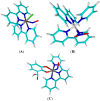Ruthenium complexes as NO donors for vascular relaxation induction
- PMID: 25004072
- PMCID: PMC6271244
- DOI: 10.3390/molecules19079628
Ruthenium complexes as NO donors for vascular relaxation induction
Abstract
Nitric oxide (NO) donors are substances that can release NO. Vascular relaxation induction is among the several functions of NO, and the administration of NO donors is a pharmacological alternative to treat hypertension. This review will focus on the physicochemical description of ruthenium-derived NO donor complexes that release NO via reduction and light stimulation. In particular, we will discuss the complexes synthesized by our research group over the last ten years, and we will focus on the vasodilation and arterial pressure control elicited by these complexes. Soluble guanylyl cyclase (sGC) and potassium channels are the main targets of the NO species released from the inorganic compounds. We will consider the importance of the chemical structure of the ruthenium complexes and their vascular effects.
Conflict of interest statement
The authors declare that there are no conflicts of interest.
Figures














Similar articles
-
Enhancing vascular relaxing effects of nitric oxide-donor ruthenium complexes.Future Med Chem. 2014 May;6(7):825-38. doi: 10.4155/fmc.14.26. Future Med Chem. 2014. PMID: 24941875 Review.
-
Comparison of the mechanisms underlying the relaxation induced by two nitric oxide donors: sodium nitroprusside and a new ruthenium complex.Vascul Pharmacol. 2007 Mar;46(3):215-22. doi: 10.1016/j.vph.2006.10.002. Epub 2006 Oct 7. Vascul Pharmacol. 2007. PMID: 17127100
-
The macrocyclic effect and vasodilation response based on the photoinduced nitric oxide release from trans-[RuCl(tetraazamacrocycle)NO](2+).J Inorg Biochem. 2007 Feb;101(2):313-20. doi: 10.1016/j.jinorgbio.2006.10.008. Epub 2006 Nov 10. J Inorg Biochem. 2007. PMID: 17141326
-
New nitric oxide donors based on ruthenium complexes.Braz J Med Biol Res. 2009 Jan;42(1):87-93. doi: 10.1590/s0100-879x2009000100013. Braz J Med Biol Res. 2009. PMID: 19219301 Review.
-
Identification of mechanisms involved in the relaxation of rabbit cavernous smooth muscle by a new nitric oxide donor ruthenium compound.Int Braz J Urol. 2012 Sep-Oct;38(5):687-94. doi: 10.1590/s1677-55382012000500015. Int Braz J Urol. 2012. PMID: 23131510
Cited by
-
NONO2P, a novel nitric oxide donor, causes vasorelaxation through NO/sGC/PKG pathway, K+ channels opening and SERCA activation.Eur J Pharmacol. 2024 Sep 15;979:176822. doi: 10.1016/j.ejphar.2024.176822. Epub 2024 Jul 22. Eur J Pharmacol. 2024. PMID: 39047965
-
Targeting the mitochondrial VDAC in hepatocellular carcinoma using a polyclonal antibody-conjugated to a nitrosyl ruthenium complex.J Biol Inorg Chem. 2018 Aug;23(6):903-916. doi: 10.1007/s00775-018-1589-x. Epub 2018 Jul 3. J Biol Inorg Chem. 2018. PMID: 29971501 Free PMC article.
-
Editorial of Special Issue Ruthenium Complex: The Expanding Chemistry of the Ruthenium Complexes.Molecules. 2015 Sep 18;20(9):17244-74. doi: 10.3390/molecules200917244. Molecules. 2015. PMID: 26393560 Free PMC article.
-
In vitro Treatment with cis-[Ru(H-dcbpy-)2(Cl)(NO)] Improves the Endothelial Function in Aortic Rings with Endothelial Dysfunction.J Pharm Pharm Sci. 2015;18(5):696-704. doi: 10.18433/j3cc9k. J Pharm Pharm Sci. 2015. PMID: 26670366 Free PMC article.
-
Extension of C. elegans lifespan using the ·NO-delivery dinitrosyl iron complexes.J Biol Inorg Chem. 2018 Jul;23(5):775-784. doi: 10.1007/s00775-018-1569-1. Epub 2018 Jun 1. J Biol Inorg Chem. 2018. PMID: 29858679
References
Publication types
MeSH terms
Substances
LinkOut - more resources
Full Text Sources
Other Literature Sources

